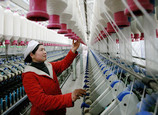
A progress
China's income gap has been a concern to many people. Each time figures are released, arguments ensue. In 2007, famous economist Li Yining said that according to his calculations, the country's Gini coefficient was lower than 0.2 and drew the conclusion that there was no polarization between the rich and the poor. The findings were subject to scathing censure, and his few supporters were submerged in criticism. During 2010, the resident income project group of the Chinese Academy of Social Sciences revealed that China's Gini coefficient was 0.382 in 1988, 0.455 in 1995, 0.454 in 2002 and 0.48 in 2007. The findings, which reflected an enlarged income gap, were widely accepted as accurate.
Subsequently, SWUFE's China Household Finance Survey and Research Center issued its own research report in last December, saying that in 2010 the country's Gini coefficient reached 0.61. Many people chose to believe the shocking figure.
However, conclusions drawn by scholars and non-governmental institutions lack authority. Therefore, some Chinese people prefer government figures on equal income, such as those given the NBS data.
"Putting aside arguments over the authenticity of figures, releasing Gini coefficient information illustrates the Chinese Government's concern over the issue," Yu said.


















 Most feared Spring Festival questions
Most feared Spring Festival questions


![]()
